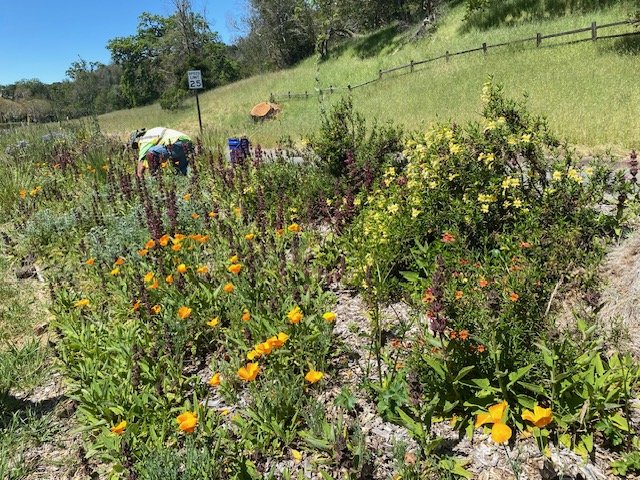Public Gardens
As awareness spreads about the importance of creating native plant habitats, pollinator gardens are being created throughout the county, in school yards, alongside libraries, in front of police stations, and on traffic islands. In addition to creating habitat for birds and bugs, these spaces also allow residents to experience and enjoy natural phenomena.
School and University Gardens
One example of an elementary school garden can be found at Neil Cummins Elementary School in Corte Madera. Developed in 2016 by a group of parents and the PTO, with support from SPAWN, the garden helps students learn about nature and their environment.
In 2020, Neil Cummins teacher Dana Swisher took over management of the garden. In 2022 she and her students, along some other garden volunteers, created a monarch way station planted with native milkweed and nectar plants.
The project expanded again in 2023, when Swisher and the fifth grade Girl Scout troop at Neil Cummins replanted a long neglected planter with pollinator-friendly plants, most of them native. The PTO has now taken over maintenance of the garden.
Dana Swisher has gone on to found Refugia, a nonprofit organization whose mission is to create wildlife habitats in partnership with schools and other community organizations. Refugia recentlyreceived a grant from Point Blue to install a native plant living classroom and increase the local habitat corridor at Hall Middle School in the Larkspur-Corte Madera School District. Planting is expected to being in the Fall of 2025.
A number of Marin school gardens have been supported by a program called Bringing Nature to School. Established in 2020 by Audrey Fusco of SPAWN and Charlotte Torgovitsky, founder of Home Ground Habitats Nursery, the program provides schools with plants and other supplies, helps design garden spaces, and works with students and teachers to plant the garden. This program has assisted with habitat gardens at Neil Cummins, Glenwood Elementary (San Rafael), Bolinas-Stinson School (Bolinas), Lagunitas School (San Geronimo), Bayside Martin Luther King Academy (Sausalito), and Marin Academy (San Rafael).
Charlotte Torgovitsky and Audrey Fusco
The College of Marin native plant garden in Kentfield is located outside the Student Services Center. The Daniel Stralka Memorial Pollinator Garden at Dominican University features plants serving as pollinators for bees and butterflies as well as providing food and nesting materials. Irrigation is supplied via the rainwater catchment tank that collects water from the a nearby rooftop.
Gardens in Urban Spaces
Local environmental groups and individuals have created gardens at public sites throughout the county. These sites provide food and shelter for pollinators as well as offering visitors an inviting space to view and enjoy nature.
The Marin Art and Garden Center (below) features a habitat garden with larval host plants that attract many species of butterflies. Michael Bogart, Garden Manager, works with high school student interns, teaching them about the care of plants and pollinators.
The Falkirk Cultural Center (below) features several demonstration gardens, including one devoted to California native plants. The gardens are maintained with the assistance of Marin Master Gardeners. They illustrate water conservation practices and include a variety of pollinator plants.
The Mill Valley Library used funds from a California State Library “Pitch and Idea” grant to create a demonstration garden (below) that teaches the importance of native plants and the necessity of water management.
The Bay Model Habitat Garden (below) in Sausalito was planted by the Marin Chapter of the California Native Plant Society. A variety of perennials and shrubs offer sustenance for pollinators. Each section of the garden focuses on some of the plants favored by a specific type of pollinator.
The Native Habitat Garden was established by Refugia Marin in 2021. Adjacent to the pond in Town Park, Corte Madera, its drought-tolerant plants offer sustenance and shelter for birds and insects and a monarch waystation provides native milkweed as well as nectar plants.
The Fairfax Library Garden was completed in 2022 with support from the county, SPAWN, and the community. The garden features milkweed and other native pollinator plants and provides a refuge for humans and pollinators alike.
In Larkspur, a mature garden can be found on the traffic median on Magnolia Avenue across from the Lark Theater, a second is located at the Central Marin Police Station on Doherty Drive, and a third is adjacent to a parking lot at the corner of Magnolia and Ward Streets.
Harvey’s Garden in Tiburon is a community garden maintained by Marin Master Gardeners. The garden is in Blackie’s Pasture, and features drought-tolerant plants. A small garden at Blackie’s grave is maintained by the Tiburon Green Team and is part of their native plantings along the Trestle Glen Roadway.
In 2009, Novato resident Marcia Basalla adopted two adjoining traffic medians on Alameda del Prado in Novato. With support from the Novato Streetscape Committee and the Novato Maintenance Department, Basalla created a thriving ecosystem of native trees, flowers, shrubs, and grasses. Learn more about this project here.















